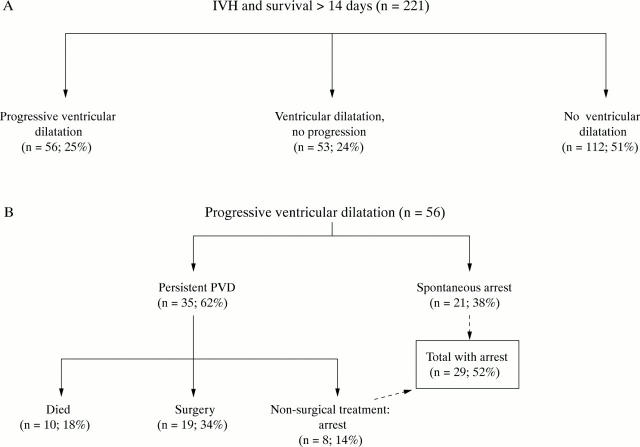Abstract
Objective: To investigate the natural history and predictors of outcome of posthaemorrhagic ventriculomegaly in the very low birthweight (VLBW) infant.
Methods: All VLBW infants admitted between September 1994 and September 1997 to the neonatal intensive care units of Brigham and Women's Hospital (Boston), Children's Hospital (Boston), and Christchurch Women's Hospital (New Zealand) with germinal matrix intraventricular haemorrhage (IVH) were identified. All charts and ultrasound scans were reviewed to define the natural history and perinatal and/or postnatal factors of value in prediction of the course of posthaemorrhagic ventriculomegaly. Progressive ventricular dilatation (PVD) was defined from the results of serial cranial ultrasound scans.
Results: A total of 248 VLBW infants had evidence of IVH (22% of all VLBW infants, mean (SD) gestational age 26.8 (2.6) weeks). A quarter of the infants exhibited PVD. Spontaneous arrest of PVD occurred without treatment in 38% of infants with PVD. Of the remaining 62% with persistent PVD, 48% received non-surgical treatment only (pharmacological and/or drainage of cerebrospinal fluid by serial lumbar punctures), 34% received surgical treatment with insertion of a ventriculoperitoneal reservoir and/or shunt, and 18% died. The development of PVD after IVH and adverse short term outcome, such as the requirement for surgery, were predicted most strongly by the severity of IVH.
Conclusions: These data reflect the natural history of PVD in the 1990s and show that, despite a slight reduction in its overall incidence, there appears to be a more aggressive course, with appreciable mortality and morbidity in the extremely premature infant. The major predictor of adverse short term outcome, defined as death or need for surgical intervention, was the severity of IVH. These findings may be valuable for the management of very small premature infants.
Full Text
The Full Text of this article is available as a PDF (111.2 KB).
Figure 1 .
Natural history of very low birthweight infants with posthaemorrhagic ventricular dilatation (PVD). IVH, Intraventricular haemorrhage.
Selected References
These references are in PubMed. This may not be the complete list of references from this article.
- Ahmann P. A., Lazzara A., Dykes F. D., Brann A. W., Jr, Schwartz J. F. Intraventricular hemorrhage in the high-risk preterm infant: incidence and outcome. Ann Neurol. 1980 Feb;7(2):118–124. doi: 10.1002/ana.410070205. [DOI] [PubMed] [Google Scholar]
- Allan W. C., Holt P. J., Sawyer L. R., Tito A. M., Meade S. K. Ventricular dilation after neonatal periventricular-intraventricular hemorrhage. Natural history and therapeutic implications. Am J Dis Child. 1982 Jul;136(7):589–593. doi: 10.1001/archpedi.1982.03970430021006. [DOI] [PubMed] [Google Scholar]
- Bozynski M. E., Nelson M. N., Rosati-Skertich C., Genaze D., O'Donnell K., Naughton P. Two year longitudinal followup of premature infants weighing less than or equal to 1,200 grams at birth: sequelae of intracranial hemorrhage. J Dev Behav Pediatr. 1984 Dec;5(6):346–352. [PubMed] [Google Scholar]
- Crowley P. A. Antenatal corticosteroid therapy: a meta-analysis of the randomized trials, 1972 to 1994. Am J Obstet Gynecol. 1995 Jul;173(1):322–335. doi: 10.1016/0002-9378(95)90222-8. [DOI] [PubMed] [Google Scholar]
- Davies M. W., Swaminathan M., Chuang S. L., Betheras F. R. Reference ranges for the linear dimensions of the intracranial ventricles in preterm neonates. Arch Dis Child Fetal Neonatal Ed. 2000 May;82(3):F218–F223. doi: 10.1136/fn.82.3.F218. [DOI] [PMC free article] [PubMed] [Google Scholar]
- Dykes F. D., Dunbar B., Lazarra A., Ahmann P. A. Posthemorrhagic hydrocephalus in high-risk preterm infants: natural history, management, and long-term outcome. J Pediatr. 1989 Apr;114(4 Pt 1):611–618. doi: 10.1016/s0022-3476(89)80707-3. [DOI] [PubMed] [Google Scholar]
- Hack M., Fanaroff A. A. Outcomes of children of extremely low birthweight and gestational age in the 1990's. Early Hum Dev. 1999 Jan;53(3):193–218. doi: 10.1016/s0378-3782(98)00052-8. [DOI] [PubMed] [Google Scholar]
- Hansen A. R., Allred E. N., Leviton A. Predictors of ventriculoperitoneal shunt among babies with intraventricular hemorrhage. J Child Neurol. 1997 Sep;12(6):381–386. doi: 10.1177/088307389701200608. [DOI] [PubMed] [Google Scholar]
- Hill A., Volpe J. J. Normal pressure hydrocephalus in the newborn. Pediatrics. 1981 Nov;68(5):623–629. [PubMed] [Google Scholar]
- Monset-Couchard M., De Bethmann O., Brouard-Orzechowski C., Relier J. P. Cotation des hémorragies péri-intraventriculaires (HPIV) du nouveau-né avec prise en compte de la latéralité et de la localisation parenchymateuse. Application à 323 cas consécutifs. J Radiol. 1987 Mar;68(3):159–166. [PubMed] [Google Scholar]
- Resch B., Gedermann A., Maurer U., Ritschl E., Müller W. Neurodevelopmental outcome of hydrocephalus following intra-/periventricular hemorrhage in preterm infants: short- and long-term results. Childs Nerv Syst. 1996 Jan;12(1):27–33. doi: 10.1007/BF00573851. [DOI] [PubMed] [Google Scholar]
- Shankaran S., Slovis T. L., Bedard M. P., Poland R. L. Sonographic classification of intracranial hemorrhage. A prognostic indicator of mortality, morbidity, and short-term neurologic outcome. J Pediatr. 1982 Mar;100(3):469–475. doi: 10.1016/s0022-3476(82)80462-9. [DOI] [PubMed] [Google Scholar]
- Szymonowicz W., Yu V. Y., Bajuk B., Astbury J. Neurodevelopmental outcome of periventricular haemorrhage and leukomalacia in infants 1250 g or less at birth. Early Hum Dev. 1986 Jul;14(1):1–7. doi: 10.1016/0378-3782(86)90164-7. [DOI] [PubMed] [Google Scholar]
- Vohr B. R., Wright L. L., Dusick A. M., Mele L., Verter J., Steichen J. J., Simon N. P., Wilson D. C., Broyles S., Bauer C. R. Neurodevelopmental and functional outcomes of extremely low birth weight infants in the National Institute of Child Health and Human Development Neonatal Research Network, 1993-1994. Pediatrics. 2000 Jun;105(6):1216–1226. doi: 10.1542/peds.105.6.1216. [DOI] [PubMed] [Google Scholar]
- de Vries L. S., Eken P., Dubowitz L. M. The spectrum of leukomalacia using cranial ultrasound. Behav Brain Res. 1992 Jul 31;49(1):1–6. doi: 10.1016/s0166-4328(05)80189-5. [DOI] [PubMed] [Google Scholar]



